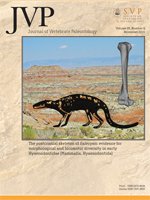The Chiweta Beds of Malawi have yielded a diverse late Permian fossil tetrapod fauna that correlates with that of the Cistecephalus Assemblage Zone of the South African Karoo Supergroup. Amongst the fossil therapsids from the Chiweta Beds is the well-preserved skull and lower jaw of a burnetiamorph, a group of biarmosuchians with numerous bosses and swellings on the skull. This specimen was reported in a preliminary paper in 2005 as the first burnetiamorph described outside of South Africa and Russia. Reanalysis of the morphology and phylogeny of this specimen places Lende chiweta, gen. et sp. nov., as the sister taxon to the clade formed by Proburnetia (Paraburnetia (Pachydectes, Bullacephalus, Burnetia, Niuksenitia)). The greatest diversity of this basal therapsid group is from South Africa, with six of nine described genera and a stratigraphic range that extends from the middle Permian Tapinocephalus Assemblage Zone to the upper Permian Dicynodon Assemblage Zone. Bearing in mind the constraints that govern fossil preservation, current data suggest that what is now southern Africa may have been the area of origin for burnetiamorphs. Under this premise, what is now central Africa represented a corridor that allowed migration of representatives of the group between the southern and northern portions of Pangea during the late Permian.
How to translate text using browser tools
1 November 2015
Lende chiweta, a New Therapsid from Malawi, and Its Influence on Burnetiamorph Phylogeny and Biogeography
Ashley Kruger,
Bruce S. Rubidge,
Fernando Abdala,
Elizabeth Gomani Chindebvu,
Louis L. Jacobs
ACCESS THE FULL ARTICLE





